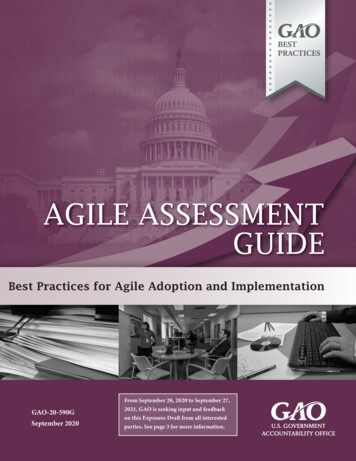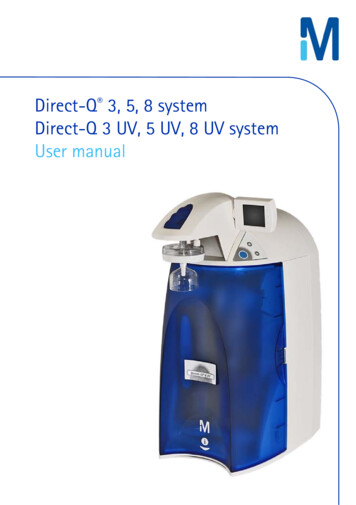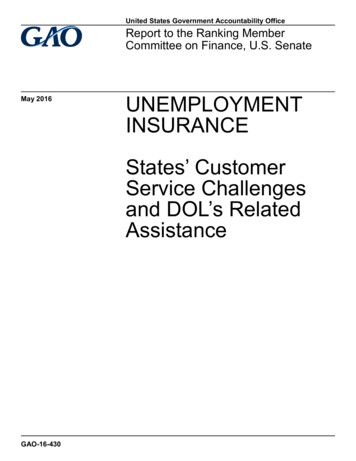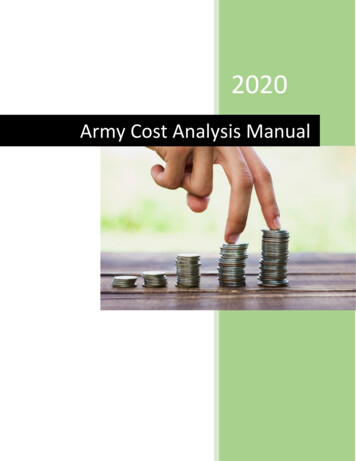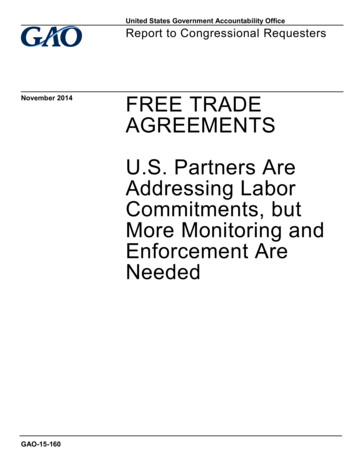
Transcription
United States Government Accountability OfficeGAOTestimonyBefore the Subcommittee on Oversightand Investigations, Committee on Energyand Commerce, House of RepresentativesFor Release on DeliveryExpected at 9:30 a.m. EDTThursday, July 22, 2010DIRECT-TO-CONSUMERGENETIC TESTSMisleading Test ResultsAre Further Complicatedby Deceptive Marketingand Other QuestionablePracticesStatement of Gregory Kutz, Managing DirectorForensic Audits and Special InvestigationsGAO-10-847T
July 22, 2010DIRECT-TO-CONSUMER GENETIC TESTSAccountability Integrity ReliabilityHighlightsHighlights of GAO-10-847T, a testimonybefore the Subcommittee on Oversightand Investigations, Committee on Energyand Commerce, House of RepresentativesTMisleading Test Results Are Further Complicated byDeceptive Marketing and Other QuestionablePracticesWhy GAO Did This StudyWhat GAO FoundIn 2006, GAO investigatedcompanies selling direct-toconsumer (DTC) genetic tests andtestified that these companiesmade medically unproven diseasepredictions. Although newcompanies have since been toutedas being more reputable—Timenamed one company’s test 2008’s“invention of the year”—expertsremain concerned that the testresults mislead consumers. GAOwas asked to investigate DTCgenetic tests currently on themarket and the advertisingmethods used to sell these tests.GAO’s fictitious consumers received test results that are misleading and oflittle or no practical use. For example, GAO’s donors often received diseaserisk predictions that varied across the four companies, indicating thatidentical DNA samples yield contradictory results. As shown below, onedonor was told that he was at below-average, average, and above-average riskfor prostate cancer and hypertension.GAO purchased 10 tests each fromfour companies, for 299 to 999per test. GAO then selected fivedonors and sent two DNA samplesfrom each donor to each company:one using factual information aboutthe donor and one using fictitiousinformation, such as incorrect ageand race or ethnicity. Aftercomparing risk predictions that thedonors received for 15 diseases,GAO made undercover calls to thecompanies seeking health advice.GAO did not conduct a scientificstudy but instead documentedobservations that could be made byany consumer. To assess whetherthe tests provided any medicallyuseful information, GAO consultedwith genetics experts. GAO alsointerviewed representatives fromeach company. To investigateadvertising methods, GAO madeundercover contact with 15 DTCcompanies, including the 4 tested,and asked about supplement sales,test reliability, and privacy policies.GAO again consulted with expertsabout the veracity of the claims.View GAO-10-847T or key components.For more information, contact Gregory Kutz at(202) 512-6722 or kutzg@gao.Contradictory Risk Predictions for Prostate Cancer and HypertensionGenderAgeConditionCompany 1Company 2Company 3Company 4Male48Prostate cancerAverageAverageBelow averageAbove averageHypertensionAverageBelow averageAbove averageNot testedSource: GAO.GAO’s donors also received DNA-based disease predictions that conflicted withtheir actual medical conditions—one donor who had a pacemaker implanted 13years ago to treat an irregular heartbeat was told that he was at decreased risk fordeveloping such a condition. Also, none of the companies could provide GAO’sfictitious African American and Asian donors with complete test results, but didnot explicitly disclose this limitation prior to purchase. Further, follow-upconsultations offered by three of the companies failed to provide the expertadvice that the companies promised. In post-test interviews with GAO, each ofthe companies claimed that its results were more accurate than the others’.Although the experts GAO spoke with believe that these tests show promise forthe future, they agreed that consumers should not rely on any of the results at thistime. As one expert said, “the fact that different companies, using the samesamples, predict different directions of risk is telling and is important. It showsthat we are nowhere near really being able to interpret [such tests].”GAO also found 10 egregious examples of deceptive marketing, includingclaims made by four companies that a consumer’s DNA could be used tocreate personalized supplement to cure diseases. Two of these companiesfurther stated that their supplements could “repair damaged DNA” or curedisease, even though experts confirmed there is no scientific basis for suchclaims. One company representative even fraudulently used endorsementsfrom high-profile athletes to convince GAO’s fictitious consumer to purchasesuch supplements. Two other companies asserted that they could predict inwhich sports children would excel based on DNA analysis, claims that anexpert characterized as “complete garbage.” Further, two companies toldGAO’s fictitious consumer that she could secretly test her fiancé’s DNA to“surprise” him with test results—though this practice is restricted in 33 states.Perhaps most disturbing, one company told a donor that an above averagerisk prediction for breast cancer meant she was “in the high risk of prettymuch getting” the disease, a statement that experts found to be “horrifying”because it implies the test is diagnostic. To hear clips of undercover contacts,see http://www.gao.gov/products/GAO-10-847T. GAO has referred all thecompanies it investigated to the Food and Drug Administration and FederalTrade Commission for appropriate action.United States Government Accountability Office
Mr. Chairman and Members of the Subcommittee:Thank you for the opportunity to discuss our follow-up investigation ofgenetic tests sold directly to consumers via the Internet. Using kits athome, consumers simply swab their cheeks or collect saliva and sendthese DNA samples back to a company for analysis and a report of theresults. While the importance of genetics in individual medical care showspromise for the future, the usefulness of the tests these companies offer ismuch debated.In 2006, we investigated four companies selling direct-to-consumer (DTC)genetic tests that purported to use DNA to deliver personalized nutritionand lifestyle guidance. We testified before the Senate Special Committeeon Aging that these companies misled consumers by providing test resultsthat were both medically unproven and so ambiguous as to bemeaningless. 1 For example, one of the results we received vaguelyindicated that our DNA donor was at “significant risk of developing theage related conditions associated with elevated levels of DNA damage.”Another stated that our donor had “faulty methylation patterns” that maylead to “an above-average risk for developing cardiac aging, brain aging,and cancer.” And though some of the companies claimed that they wouldprovide lifestyle advice based on a consumer’s DNA, we found that theysimply provided generally accepted health guidance linked to backgroundinformation submitted by our donors on test questionnaires. Further, twoof the companies we tested recommended costly dietary supplements thatwere in reality nothing more than inexpensive multivitamins available atany drug store.As a result of these findings, in 2006 the Centers for Disease Control andPrevention (CDC) in conjunction with the Food and Drug Administration(FDA) and the Federal Trade Commission (FTC) issued alerts warningconsumers to be wary of claims made by these types of DTC genetictesting companies. In October 2008, FTC again warned consumers that “nostandards govern the reliability or quality of at-home genetic tests. TheFDA and Centers for Disease Control and Prevention recommend thatgenetic tests be done in a specialized laboratory and that a doctor orcounselor with specialized training interpret the results.”1GAO, Nutrigenetic Testing: Tests Purchased from Four Web Sites Mislead Consumers,GAO-06-977T (Washington D.C.: July 27, 2006).Page 1GAO-10-847T
Despite these warnings, several new DTC genetic test companies havebeen touted as being more reputable and medically accurate than those wetested previously; in 2008, Time magazine named one new company’s testthe “invention of the year.” More recently, another company’s plan to selltests at retail pharmacies has drawn significant attention from the mediaand scientists. However, given the scientific evidence currently available,many experts remain concerned that the medical predictions contained inthe results mislead consumers. In this context, you requested that weproactively test DTC genetic products currently on the market and theadvertising methods used to sell these products to consumers.To investigate DTC genetic products currently on the market, wepurchased tests, for 299 to 999, from a nonrepresentative selection offour of the dozens of genetic testing companies selling kits to consumerson the Internet. 2 Using online search terms likely to be used by actualconsumers, we identified and selected these companies because they werefrequently cited as being credible by the media and in scientificpublications and because they all provided consumers with riskpredictions, accessible through secure Web sites, for a range of diseasesand conditions. 3 Although their tests are not identical, all four companies’Web sites contain a variation of the statement that their tests helpconsumers and their physicians detect disease risks early so that they cantake preventive steps to reduce these risks. They also note that their testsare not intended to provide medical advice or to treat or diagnose disease.We purchased 10 tests from each company (40 tests in total) to comparerisk predictions for a variety of serious illnesses and determine whetherthe companies were consistent in their predictions. We selected forcomparison 15 common diseases and conditions that were tested by atleast three of the four companies: Alzheimer’s disease, atrial fibrillation (atype of irregular heart beat), breast cancer, celiac disease (a chronicdigestive problem caused by an inability to process gluten), colon cancer,heart attack, hypertension, leukemia, multiple sclerosis, obesity, prostate2The companies are not the same as the companies tested in our 2006 investigation.3The companies also provided consumers with ancestry reports; drug response tests; andpredictions for various traits and characteristics, such as eye color. We focused ourinvestigation on testing the companies’ disease risk predictions.Page 2GAO-10-847T
cancer, restless leg syndrome, rheumatoid arthritis, type 1 diabetes, andtype 2 diabetes. 4As shown in table 1, we then selected five DNA donors and created twoprofiles for each donor, one using factual information about the donor andone using fictitious information, including age, race or ethnicity, andmedical history.Table 1: Donor and Profile InformationDonor12345ProfileGenderAgeRace or EthnicitySelected Medical History InformationFactualFemale37CaucasianColon cancerFictitiousFemale68African AmericanHypertension and diabetesFactualFemale41CaucasianBreast cancer, diabetes, and heart diseaseFictitiousFemale19AsianHeart arrhythmiasFactualMale48CaucasianAsthma, non-melanoma skin cancer, and heart diseaseFictitiousMale69African AmericanAuto-immune disordersFactualMale61CaucasianColon cancer, heart disease, and atrial fibrilationFictitiousMale53CaucasianProstate cancer and hypertensionFactualMale63CaucasianType 2 diabetes, Alzheimer’s disease, and obesityFictitiousMale29HispanicAsthma and thyroid and colon cancerSource: GAONote: We did not alter the gender on the donors’ fictitious profiles because we believed that thisdifference would have been easily identified by these companies.For each donor, we sent two DNA samples (saliva or a cheek swab) toeach company—one sample using the factual profile and one using thefictitious—to determine whether altering the donors’ backgrounds had anyeffect on the companies’ DNA analysis. Three of the four companies askedfor age and race or ethnicity prior to purchase; only one asked for medicalhistory information. We also made undercover telephone calls to thecompanies seeking additional medical advice for both our factual andfictitious donors. We then documented our observations on the test resultsand advice we received. It is important to emphasize that we did not4Type 1 diabetes is usually first diagnosed in children, teenagers, or young adults. With thisform of diabetes, the cells of the pancreas no longer make insulin because the body’simmune system has attacked and destroyed them. Type 2 diabetes is the most commonform of diabetes. People can develop type 2 diabetes at any age—even during childhood.This form of diabetes usually begins with insulin resistance, a condition in which fat,muscle, and liver cells do not use insulin properly.Page 3GAO-10-847T
conduct a rigorous scientific study; our observations are those that couldbe made by any consumer. To assess whether we received anyscientifically based or medically useful information, we consulted withexternal experts in the field of genetics and incorporated their commentsas appropriate. Our primary consultant was Dr. James Evans, the Directorof Adult Genetics Services at the University of North Carolina and theEditor-in-Chief of Genetics in Medicine, the official journal of theAmerican College of Medical Genetics. After we completed our proactivetesting, we visited each company and interviewed representatives whowere willing to speak with us. We did not notify the companies prior tothese visits and did not specifically disclose the results of our undercovertesting or reveal the identities of our donors or the other companies thatwe tested.To investigate the advertising methods used to sell DTC genetic products,we reviewed the Web sites of a nonrepresentative selection of 15 genetictesting companies, including the 4 from which we purchased tests. Weidentified the companies by again using online search terms likely to beused by actual consumers. Posing as fictitious consumers, we madecontact with these companies, both by phone and in person, seekingadditional information about genetic testing. During these contacts, weasked a series of questions about the reliability and usefulness of testresults, privacy policies regarding consumers’ genetic information, and thesale of supplements or other products. To assess the accuracy andreasonableness of the marketing claims, we again consulted with externalexperts in the field of genetics. We also purchased supplements sold byone of the companies.Our findings are limited to the individual DTC genetic test companies weinvestigated and cannot be projected to any other companies. Weperformed our work from June 2009 to June 2010 in accordance withstandards prescribed by the Council of Inspectors General for Integrityand Efficiency.Test Results AreMisleading and ofLittle Use toConsumersThe test results we received are misleading and of little or no practical useto consumers. Comparing results for 15 diseases, we made the followingobservations: (1) each donor’s factual profile received disease riskpredictions that varied across all four companies, indicating that identicalDNA can yield contradictory results depending solely on the company itwas sent to for analysis; (2) these risk predictions often conflicted with thedonors’ factual illnesses and family medical histories; (3) none of thecompanies could provide the donors who submitted fictitious AfricanPage 4GAO-10-847T
American and Asian profiles with complete test results for their ethnicitybut did not explicitly disclose this limitation prior to purchase; (4) onecompany provided donors with reports that showed conflictingpredictions for the same DNA and profile, but did not explain how tointerpret these different results; and (5) follow-up consultations offered bythree of the companies provided only general information and not theexpert advice the companies promised to provide. The experts we spokewith agreed that the companies’ claims and test results are bothambiguous and misleading. Further, they felt that consumers who areconcerned about their health should consult directly with their physiciansinstead of purchasing these kinds of DTC genetic tests. See appendix I forcomprehensive information on the test results we received for each donor.Different companies often provide different results for identicalDNA: Each donor received risk predictions for the 15 diseases that variedfrom company to company, demonstrating that identical DNA samplesproduced contradictory results. Specifically, in reviewing the test resultsacross all four companies for the donors’ factual profiles, we found thatDonor 1 had contradictory results for 11 diseases, Donor 2 for 9 diseases,Donor 3 for 12 diseases, Donor 4 for 10 diseases, and Donor 5 for 9diseases. Specific examples of these contradictory predictions are listedbelow; note that some of the diseases we compared were only tested bythree of the four companies. To facilitate comparison among companies,we chose to use the terms “below average,” “average,” and “aboveaverage” to describe the risk predictions we received; the exact languageused by each of the companies is reprinted in appendix I. For Donor 1, Company 1 predicted an above-average risk of developingleukemia, while Company 2 predicted a below-average risk, andCompany 3 reported that she had an average risk for developing thedisease. In addition, Companies 2 and 4 told the donor that her risk forcontracting breast cancer was above average, but Companies 1 and 3found her only to be at average risk. See figure 1.Figure 1: Selected Contradictory Risk Predictions for Donor 1GenderAgeConditionCompany 1Company 2Company 3Company 4Female37LeukemiaBreast cancerAbove averageAverageBelow averageAbove averageAverageAverageNot testedAbove averageSource: GAO.Page 5GAO-10-847T
Companies 1 and 2 claimed that Donor 2 had an above-average risk ofdeveloping type 1 diabetes, while Company 3 reported that she was atbelow-average risk for the disease. Further, Company 2 predicted shewas at above-average risk for restless leg syndrome, Company 1claimed she was at below-average risk for the condition, and Company4 found that she was at average risk. See figure 2.Figure 2: Selected Contradictory Risk Predictions for Donor 2GenderAgeConditionFemale41Type 1 diabetesAbove averageRestless leg syndrome Below averageCompany 1Company 2Company 3Company 4Above averageAbove averageBelow averageNot testedNot testedAverageSource: GAO. Company 4 claimed that Donor 3’s risk of developing prostate cancerwas above-average, Company 3 found that he was at below-averagerisk, and Companies 1 and 2 found that he was at average risk. Forhypertension, Company 3 found that he had an above-average risk ofdeveloping the condition, Company 2 found that he was at belowaverage risk, and Company 1 found he was at average risk. See figure 3.Figure 3: Selected Contradictory Risk Predictions for Donor 3GenderAgeConditionCompany 1Company 2Company 3Company 4Male48Prostate cancerHypertensionAverageAverageAverageBelow averageBelow averageAbove averageAbove averageNot testedSource: GAO. Donor 4 was told by Companies 1 and 4 that he was at above-averagerisk for celiac disease, but Company 2 reported that he was only ataverage risk. In addition, Companies 1 and 4 found that he was atbelow-average risk for multiple sclerosis, while Companies 2 and 3found that he was at average risk. See figure 4.Figure 4: Selected Contradictory Risk Predictions for Donor 4GenderAgeConditionCompany 1Company 2Company 3Company 4Male61Celiac diseaseMultiple sclerosisAbove averageBelow averageAverageAverageNot testedAverageAbove averageBelow averageSource: GAO.Page 6GAO-10-847T
For Donor 5, Companies 2 and 3 reported an above-average risk forheart attacks, and Companies 1 and 4 identified only an average risk.Company 2 found him to be at below-average risk 5 for atrial fibrillation,while Companies 1, 3, and 4 predicted an average risk. See figure 5.Figure 5: Selected Contradictory Risk Predictions for Donor 5GenderAgeConditionCompany 1Company 2Company 3Company 4Male63Heart attackAtrial fibrillationAverageAverageAbove averageBelow averageAbove averageAverageAverageAverageSource: GAO.These contradictions can be attributed in part to the fact that thecompanies analyzed different genetic “markers” in assessing the donors’risk for disease. As described in a recent article published in the sciencejournal Nature, researchers determine which markers occur morefrequently in patients with a specific disease by conducting “genome-wideassociation studies, which survey hundreds of thousands or millions ofmarkers across control and disease populations.” 6 DTC companies usethese publicly available studies to decide which markers to include in theiranalyses, but none of the companies we investigated used the exact samemarkers in its tests. For example, Company 1 looked at 5 risk markers forprostate cancer, while Company 4 looked at 18 risk markers.In our post-test interviews, representatives from all four companiesacknowledged that, in general, DTC genetic test companies test fordifferent risk markers and that this could result in companies havingdifferent results for identical DNA. When we asked the representativeswhether they thought that any DTC genetic test companies currently onthe market were more accurate than others, all claimed that their owncompanies’ tests were better than those offered by their competitors. Forexample, Company 1 said that it offers consumers more information thanother companies because its results are based on both preliminaryresearch reports as well as clinical data. Company 2 claimed that othercompanies do not test for as many markers as it does and that while none5In a “research” report contained in the test results, Company 1 also found this donor to beat below-average risk for atrial fibrillation. These conflicting reports will be discussed laterin the testimony.6Pauline C. Ng, Sarah S. Murray, Samuel Levy, and Craig J. Venture, An Agenda forPersonalized Medicine, Nature, vol. 461, October 8, 2009.Page 7GAO-10-847T
of the companies are “wrong,” using more markers is “probably moreaccurate.” Company 2 also stated that disparate test results from differentcompanies are “caused, in part, due to a lack of guidance from the federalgovernment, CDC in particular.” Company 3 similarly claimed to test formore markers than other companies and stated that its test is “the best.”Company 3 also said that there is a movement within the DTC genetic testindustry to standardize test results, but that such standardization is a workin progress. Finally, Company 4 claimed that it uses stricter criteria toselect risk markers than other companies. Company 4 also told us that ithas been involved in a collaborative effort with other DTC genetic testcompanies to develop standard sets of markers, but stated that there aremany unresolved differences in philosophy and approach.When we asked genetics experts if any of the companies’ markers anddisease predictions were actually more accurate than the others, they toldus that there are too many uncertainties and ambiguities in this type oftesting to rely on any of the results. Unlike well-established genetic testingfor diseases like cystic fibrosis, the experts feel that these tests are“promising for research, but the application is premature.” In other words,“each company’s results could be internally consistent, but not tell the fullstory .[because] the science of risk prediction based on genetic markersis not fully worked out, and that the limitations inherent in this sort of riskprediction have not been adequately disclosed.” As one expert furthernoted, “the fact that different companies, using the same samples, predictdifferent directions of risk is telling and is important. It shows that weare nowhere near really being able to interpret [such tests].” We also askedour experts if any of our donors should be concerned if the companies allagreed on a risk prediction; for example, all four companies told Donor 1she was at increased risk for Alzheimer’s disease. The experts told us thisconsensus means very little because there are so many demographic,environmental, and lifestyle factors that contribute to the occurrence ofthe types of diseases tested by the four companies.Risk predictions sometimes conflict with diagnosed medicalconditions or family history: Four of our five donors received testresults that conflicted with their factual medical conditions and familyhistories. 7 When we asked the experts about these discrepancies, they toldus that the results from these DTC tests are not conclusive because the7Company 3 is the only company that asked consumers to provide medical historyinformation as part of the DNA submission process.Page 8GAO-10-847T
tests are not diagnostic, as is noted on all of the companies Web sites.Because risks are probabilistic by definition, it is very likely thatconsumers will receive results from these companies that do not comportwith their knowledge of their own medical histories. However, one expertnoted that the discrepancies between actual health and the predicationsmade by these companies also serve to illustrate the lack of robustness ofsuch predictive tests. Moreover, experts fear that consumers maymisinterpret the test results because they do not understand suchdistinctions. For example, a consumer with a strong family history of heartdisease may be falsely reassured by below-average risk predictions relatedto heart attacks and consequently make poor health choices. In fact, oneexpert told us that “family history is still by far the most consistent riskfactor for common chronic conditions. The presence of family historyincreases the risk of disease regardless of genetic variants and the currentgenetic variants do not explain the familial clustering of diseases.” Anotherexpert stated that “the most accurate way for these companies to predictdisease risks would be for them to charge consumers 500 for DNA andfamily medical history information, throw out the DNA, and then makepredictions based solely on the family history information.” Examples weidentified include the following: Donor 2 has a family history of heart disease yet all four companiespredicted that she was at average risk for having a heart attack. Donor2 also has a family history of type 1 diabetes, but Company 3 reportedthat she was at below-average risk for the disease. Donor 3 has a family history of heart disease, but Companies 1, 2, and 3reported that he was at average risk for having a heart attack andCompany 4 reported he was at below-average risk. Donor 4 had a pacemaker implanted 13 years ago to treat atrialfibrillation. However, Company 1 and 2 found that he was at belowaverage risk for developing atrial fibrillation, 8 and Companies 3 and 4claimed that he was at average risk. Donor 4 is also a colon cancersurvivor, but Company 2 reported that he was at average risk ofdeveloping the disease.8In another report contained in the test results, Company 1 also found this donor to be ataverage risk for atrial fibrillation. These conflicting reports will be discussed later in thetestimony.Page 9GAO-10-847T
Donor 5 has Type 2 diabetes, but Companies 1, 2, and 3 indicated thathe had an average risk of developing the disease. Donor 5 is alsooverweight, but all four companies found him to be at average risk forobesity.In our post-test interviews, representatives from all four companiesreiterated that their tests are not diagnostic, but they all believe that theirtests provide consumers and their doctors with useful information.Specifically, Company 1 stressed that its tests empower consumers torecognize their risk of developing a health-related condition and then takethe information to a doctor for further discussion. Company 2 emphasizedthat its tests provide consumers with the “incentive” to be “aggressive”about their health, while Company 3 said its goal is to “empowerindividuals with information to help them make necessary lifestylechanges.” Similarly, Company 4 stated that its risk predictions are a usefulfirst step in that they offer “something for the consumer and theirphysician to consider in deciding whether or when to proceed with moreinvasive or costly tests.” However, experts we spoke with cautioned thatmost doctors are not adequately prepared to use DTC genetic testinformation to treat patients. In addition, experts noted that there iscurrently no data or other evidence to suggest that consumers have takensteps to improve their health as a result of taking DTC genetic tests. Asone expert noted, “even if such information is found to be an especiallyeffective motivator of behavioral change, we’re in trouble because foreveryone you find who is at increased disease risk, you’ll find another whois at decreased risk. So if this information is actually powerful inmotivating behavior then it will also motivate undesirable behaviors inthose found to be at low risk.”Fictitious profiles did not receive complete test results: Many ofthese studies the companies use to make risk predictions apply only tothose of European ancestry. Consequently, our fictitious Asian and AfricanAmerican donors did not always receive risk predictions that wereapplicable to their race or ethnicity, although the companies either did notdisclose these limitations prior to purchase or placed them in lengthyconsent forms. The experts we spoke to agreed that these limitationsshould be “clearly disclosed upfront” and suggested that our fictitiousdonors try to get their money back. Companies 2 and 3 did give us arefund, but Company 1 refused and company 4 never responded to ourrequest. In our post-test interviews, company representativesacknowledged that race and ethnicity do affect disease risk predictions,but that most genetic research has only been done on persons of Europeanancestry and therefore such individuals receive more accurate results.Page 10GAO-10-8
advertising methods, GAO made undercover contact with 15 DTC companies, including the 4 tested, and asked about supplement sales, test reliability, and privacy policies. GAO again consulted with experts about the veracity of the claims. GAO’s fictitious consumers received test resul


